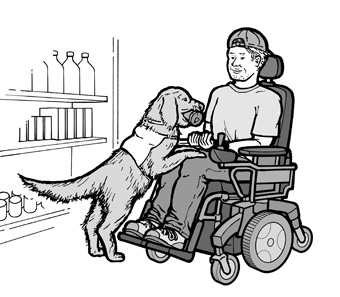



banner.jpg)


Personal devices and services
Businesses are not required to provide personal devices (such as wheelchairs), individually prescribed devices (such as eyeglasses or hearing aids), or services of a personal nature (such as assistance in eating, toileting, or dressing), to customers with disabilities. A business may choose to provide services like this as a way to attract customers. For example, some large retail stores provide electric carts for use by customers while shopping. Some fancy dress shops provide assistance for a customer trying on clothes in the dressing room.
The ADA does not require these services; it leaves it up to the business to decide what services it wants to provide. The ADA simply says a business should provide the same goods and services to all of its customers, including those with disabilities.
Service animals
Businesses must allow people with disabilities to bring their service animals into all areas of the business where customers are normally allowed to go. Service animals are dogs that are individually trained to perform tasks for people with disabilities. Typically, restaurants, stores, and other businesses with a "no pets" policy must make an exception to the policy when a customer has a service animal.

A service animal gives a can of soda
to a young man using a wheelchair.
If in doubt, you may ask the person if his or her animal is a service animal or ask what tasks the animal has been trained to perform. However, you should not expect the person to show a special ID card for the animal and should not ask about the person’s disability. Many uncomfortable situations can be avoided by educating staff about the rights of people who use service animals. Frequently Asked Questions about Service Animals and the ADA provides additional information on this subject.
Most people are familiar with guide dogs that help people who are blind to get around safely. But there are many other types of service animals that assist people with a wide range of disabilities. A service animal can be trained to pull a wheelchair or retrieve objects for people who use wheelchairs, alert people who are deaf to sounds in the environment, alert people with epilepsy to an impending seizure, help people with autism to stay focused, and perform many other tasks. Most people with disabilities who use service animals find the animals essential for coping with situations in everyday life.
If a service animal is out of control and presents a direct threat to others, you may ask the customer to remove it from the premises.
|
|
|
|
|
|




